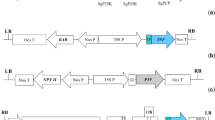Abstract
We have isolated a cDNA encoding transaldolase, an enzyme of the pentose-phosphate pathway, from potato (Solanum tuberosum). The 1.5 kb cDNA encodes a protein of 438 amino acid residues with a molecular mass of 47.8 kDa. When the potato cDNA was expressed in Escherichia coli a 45 kDa protein with transaldolase activity was produced. The first 62 amino acids of the deduced amino acid sequence represent an apparent plastid transit sequence. While the potato transaldolase has considerable similarity to the enzyme from cyanobacteria and Mycobacterium leprae, similarity to the conserved transaldolase enzymes from humans, E. coli and Saccharomyces cerevisiae is more limited. Northern analysis indicated that the transaldolase mRNA accumulated in tubers in response to wounding. Probing the RNA from various potato tissues indicated that the transaldolase mRNA accumulation to higher levels in the stem of mature potato plants than in either leaves or tubers. These data are consistent with a role for this enzyme in lignin biosynthesis.
Similar content being viewed by others
References
AltschulSF, GishW, MillerW, MyersEW, LipmanDJ: Basic local alignment search tool. J Mol Biol 215: 403–410 (1990).
BankiK, HalladeyD, PerlA: Cloning and expression of the human gene for transaldolase. J Biol Chem 269: 2847–2851 (1994).
BrandK: Transaldolase. In: BergmeyerHU (ed) Methoden der enzymatischen Analyse, pp. 752–756. Verlag Chemie, Weinheim (1974).
DyerWE, HenstrandJM, HandaAK, HerrmannKM: Wounding induces the first enzyme of the shikimate pathway in Solanaceae. Proc Natl Acad Sci USA 86: 7370–7373 (1989).
GarbarinoJE, RockholdDR, BelknapWE: Expression of stress-responsive ubiquitin genes in potato tubers. Plant Mol Biol 20: 235–244 (1992).
GavelY, vonHeijneG: A conserved cleavage-site motif in chloroplast transit peptides. FEBS Lett 261: 455–458 (1990).
HerrmannKM: The shikimate pathway as an entry to aromatic secondary metabolism. Plant Physiol 107: 7–12 (1995).
HoreckerBL, MehlerAH: Carbohydrate metabolism. Annu Rev Biochem 24: 207–274 (1955).
HoreckerBL, SmyrniotisPZ: Yeast transaldolase. Fed Proc 13: 232 (1954).
JacobyJ, HollenbergCP, HeinschJJ: Transaldolase mutants in the yeast Kluyveromyces lactis provide evidence that glucose can be metabolized through the pentose phosphate pathway. Mol Microbiol 10: 867–876 (1993).
JonesJD, HenstrandJM, HandaAH, HerrmannKM, WellerSC: Impaired wound induction of a 3-deoxy-D-arabino-heptulosonate-7-phosphate (DAHP) synthase and altered stem development in transgenic potato plants expressing a DAHP synthase antisense construct. Plant Physiol 108: 1413–1421 (1995).
KurokiG, ConnEE: Increased chorismate mutase levels as a response to wounding in Solanum tuberosum L. tubers. Plant Physiol 86: 895–898 (1988).
LawtonMA, LambCJ: Transcriptional activation of plant defense genes by fungal elicitor, wounding and infection. Mol Cell Biol 7: 335–341 (1987).
MiosgaT, Schaaff-GerstenschlaegerI, FrankenE, ZimmermanFK: Lysine 144 is essential for the catalytic activity of Saccharomyces cerevisiae transaldolase. Yeast 9: 1241–1249 (1993).
RickeyTM, BelknapWR: Comparison of the expression of several stress responsive genes in potato tubers. Plant Mol Biol 16: 1009–1018 (1991).
SchaaffI, HohmannS, ZimmermannFK: Molecular analysis of the structural gene for yeast transaldolase. Eur J Biochem 188: 597–603 (1990).
SchmidJ, AmrheinN: Molecular organization of the shikimate pathway in higher plants. Phytochemistry 39: 737–749 (1995).
SchnarrenbergerC, FlechnerA, MartinW: Enzymatic evidence for a complete oxidative pentose phosphate pathway in chloroplasts and an incomplete pathway in the cytosol of spinach leaves. Plant Physiol 108: 609–614 (1995).
StapletonA, AllenPV, FriedmanM, BelknapWR: Purification and characterization of solanidine glucosyltransferase from the potato (Solanum tuberosum). J Agric Food Chem 39: 1187–1193 (1991).
StapletonA, AllenPV, TaoHP, BelknapWR, FriedmanM: Partial amino acid sequence of potato solanidine UDP-glucose glucosyltransferase purified by new anion-exchange and size exclusion media. Prot Expr Purif 3: 85–92 (1992).
StudierFW, RosenbergAH, DunnJJ, DubendorffJW: Use of T7 RNA polymerase to direct expression of cloned genes. Methods Enzymol 185: 60–89 (1990).
SummersML, MeeksJC, SeungS, WolfRE: Nucleotide sequence of an operon in Nostoc sp. strain ATCC29133 encoding four genes of the oxidative pentose phosphate cycle. Plant Physiol 107: 267–268 (1995).
VerwoerdTC, DekkerBMM, HoekemaA: A small-scale procedure for the rapid isolation of plant RNAs. Nucl Acids Res 17: 2362 (1989).
YuraT, MoriH, NagaiH, NagataT, IshimaA, FujitaN, IsonoK, MizobuchiK, NakataA: Systematic sequencing of the Escherichia coli genome: analysis of the 0–2.4 min region. Nucl Acids Res 20: 3305–3308 (1992).
Author information
Authors and Affiliations
Rights and permissions
About this article
Cite this article
Moehs, C.P., Allen, P.V., Friedman, M. et al. Cloning and expression of transaldolase from potato. Plant Mol Biol 32, 447–452 (1996). https://doi.org/10.1007/BF00019096
Received:
Accepted:
Issue Date:
DOI: https://doi.org/10.1007/BF00019096




